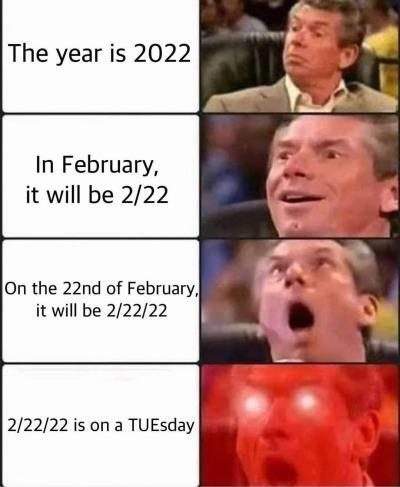Palindrome Date Finder
Have you noticed something odd in your calendar this February? Don't worry; you didn't miss a leap year. There is, however, something quite unique happening this month. Look to the second half, and you might notice it… that's right, it's !
Palindromic dates in the MM/DD/YY format are quite a feat. It's not often that the number of months can match the number of years and give such unique results as the upcoming "Twosday".
Even more amazing is that "Twosday" is also a palindrome in the DD/MM/YYYY format: 22/02/2022. According to , "Eight-digit palindrome dates are very rare and are clustered in the first three or so centuries at the beginning of a millennial, and then don't show up for 600 to 700 years, until they appear as a cluster in the next millennium".
Although we may not believe in such things as lucky numbers, we genuinely think these dates are special and worth celebrating. They make great occasions to take a moment to ponder on the beauty of numbers and notice all the interesting patterns that appear around us in our seemingly chaotic lives. That's why we decided to celebrate "Twosday", and we want to help you notice all the other special days like it - so we created this palindrome date finder.

What are palindromes?
Upon hearing the word “palindrome”, most people think of word plays and puns based on the repetition of letters. That is, in most part, correct, but it’s by no means all that the world of palindromes has to offer! In its most broad meaning, a palindrome is a repeating, symmetrical pattern of signs that doesn’t change no matter what side we look at it from – not limited only to the letters of the alphabet!
There are many types of palindromes, and only some of them consist of words and letters. You can also find these repeating patterns in dates, numbers, even music! The most common palindrome types include:
- Character-unit palindromes: words that read the same backward and forward. Examples in English include such words as kayak, level, and civic.
💡 You might have heard about the most notorious example of a character-unit palindrome, as it was quite popular around the Internet not too long ago. We are, of course, talking about the word aibohphobia – which, quite ironically, is the official name for an irrational fear of palindromes.
-
Name palindromes: actually a subset of character-unit palindromes. These are simply names that read the same no matter the direction, such as Bob, Hannah, or Otto.
-
Musical palindromes that consist of notes in a palindromic pattern. For instance, if you were to play a melody that goes A, B, E, B, A, that would be a palindrome. The musical world has many examples of great works of art based around this principle, such as Joseph Haydn's Symphony No. 47.
-
Sentence palindromes: complete phrases that consist of the same words read backward and forward. The sentence "Go hang a salami, I'm a lasagna hog" is an example of such a palindrome.
-
Palindromic numbers: numbers whose digits are the same read backward and forward. For example, 10101 or 22322. Interestingly, in the mathematical view, all single digits are palindromes - after all, they start and end with the same sign! Although usually considered in the decimal system, palindromicity can be applied to the natural numbers in all numerical systems. You can read more about palindromic numbers further down.
-
Palindrome dates: – the star of this tool – are dates whose digits form a palindrome. For example, did you know that February 2nd, 2020, is officially known as the Universal Palindrome Day? That is because no matter the date format, on that day, the digits form the palindrome: 02/02/2020!

How to use this palindrome date finder?
Our palindrome date finder is a concise tool that you’re bound to find easy to use! All you need to do is fill it in with some information, and the calculator will do the rest for you.
The first batch of information you need to give the finder is:
- The date format – choose whether you state the day or the month first.
- The year format – you can pick from four and two digits.
- What you want the finder to do – give you all palindrome dates between two certain days, or show you any number (between 1 and 100) of the upcoming palindrome dates.
Depending on your choice, you will be asked to either choose the start and end date for your search or give the number of palindrome dates you want to see. Once that is done, voila! You will find your results below the calculator.
How old are you going to be in a certain palindrome date? Our chronological age calculator takes your birthday, any date, and gives you the answer!
Why do we care about palindromes?
This question could be answered in three short words: humans love patterns.
The word "love", however, is a bit of a misnomer. It only takes a little bit of research to realize that finding patterns all around us is more of a biological necessity than a simple pleasure. You see, our brains evolved to find them in order to ensure our survival. In the words of science popularizer Neil deGrasse Tyson:
"Over centuries of evolution, humans' pattern recognition skills determined natural selection. Hunters skilled at spotting prey and predator and telling poisonous plants from healthy ones offered them a better chance of survival than those blind to the patterns. It enabled the survivors to pass on those pattern-friendly genes to future generations."
Indeed, once we start thinking about it, it's easy to notice our tendency to see patterns manifesting themselves in many different forms. For example, have you ever looked at a random object and realized that… it’s apparently looking back at you?!

This is an example of a phenomenon known as face pareidolia – the human brain's deeply ingrained tendency to recognize the patterns that define a face even in the most unexpected of places. If you've ever wondered why Jesus appears on so many slices of toast these days – now you know why 🍞😉
Our tendency to see and, above all, enjoy palindromes most likely stems from the same root. We, as human beings, are inherently inclined to not only recognize patterns but also to assign them with meaning. And since most of us no longer have to utilize these tendencies to ensure survival, we have the luxury of making them curiosities and fun, interesting instances of order and repetitiveness in the otherwise quite random world that we live in. Or, in the case of palindrome dates, we even treat them as mnemonic devices for important events in our lives!
The beauty of repetitive patterns in numbers makes palindrome dates stand out in the calendar – and makes them easy to remember. You might be surprised by just how many people decide to celebrate this beauty by choosing palindrome dates for the most important days of their lives. For example, in Las Vegas – a spot known for being a popular wedding destination - ! And even more couples are being drawn by the upcoming "Twosday", February 22nd, with American chapels expecting it to be the busiest wedding day ever. Use our speed calculator to find how fast you have to drive there to arrive on time.
Palindromic numbers – the beauty in math
Palindromes in mathematics are ubiquitous. For one, all the single digits (0, 1, 2, 3, 4, 5, 6, 7, 8, 9) are technically palindromes – they do look the same no matter which "side" you consider them from. They are just a drop in the sea of interesting examples that showcase the beauty of numbers and the relationships between them.
It’s important to note that palindromic numbers can be seen in practically any numerical system one can think of. It’s not necessary to venture outside most people’s comfort zone of the decimal system to find fascinating instances, though. An excellent example of palindromes occurring in mathematics is the case of perfect powers.
There exist countless palindromic perfect powers , where:
- is a natural number (); and
- , or .
Examples of such palindromic squares include 121, 484, 676, 10201, 12321, 14641; palindromic perfect cubes are, among others, 1331, 1030301, 1367631; and you can even find palindromic fourth powers such as 14641, 10406040 or 1004006004001.
You don’t have to wander into the realm of powers to find palindromic numbers, though. In fact, there’s quite a lot to come across if you simply enumerate… As we’ve already established, in the decimal system, there are exactly ten single-digit palindromes, but on top of that, we have:
- 9 palindromic numbers with two digits (11, 22, 33, 44, 55, 66, 77, 88, 99),
- 90 palindromic numbers with three digits (for example 101, 111, 121, and so on to 999), and
- 90 palindromic numbers with four digits (1001, 1111, 1221, …, 9779, 9889, 9999).
💡 Did you know you can create palindromes from non-palindromic numbers? The operation is known as the Lychrel process, and it works by "reversing" the digits of any number and then adding them. After doing it several times, you will get a palindrome at some point! Let's go through an example, starting with the number 273.
- 273 → 372
- 273 + 372 = 645
- 645 → 546
- 645 + 546 = 1191
- 1191 → 1911
- 1191 + 1911 = 3102
- 3102 → 2013
- 3102 + 2013 = 5115
And voila! Using the Lychrel procedure, we easily arrived at the palindromic number 5115 starting from a non-palindrome.
How can you celebrate palindrome day?
Palindromes can be a great way to teach children about several things – from math, through new vocabulary, to even music! And what better occasion is there to show your students the beauty of palindromes than the upcoming Twosday? If you're a teacher, we highly encourage you to take this opportunity and get ready with some special lesson plans. Hopefully, this shortlist will give you some inspiration!
- Time capsules. If you're teaching first grade, you're presented with a truly unique opportunity of giving your students a gift they will cherish for years after they finally graduate. Celebrate 22/02/2022 by creating a time capsule that your kids will open on the next big palindrome of their life, (0)3/(0)3/(20)33 – coincidentally, their senior year of high school!
- Palindrome writing game. You can engage your students with a bit of realization. Have them write down as many 3, 4, or 5-letter-long palindromes as they can!
- Encourage creativity by making the students write poems using mostly palindromes. You might be surprised by how wild these poems can get!
- Finally, have your students engage in a guessing game – let them estimate how many palindrome dates there will be in the next few years. You can use this palindrome date finder to check who is the closest!
